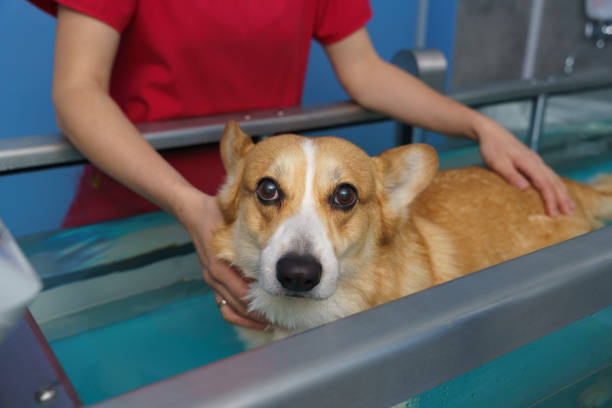Aquatic Therapy for Canine Rehabilitation: A Splash into Healing
The world of veterinary medicine is constantly evolving, and one innovative approach making waves in canine rehabilitation is aquatic therapy. This cutting-edge treatment method is revolutionizing the way we help injured or aging dogs regain mobility and improve their quality of life. From underwater treadmills to swimming sessions, aquatic therapy offers a unique blend of low-impact exercise and resistance training that's proving to be a game-changer for our four-legged friends.

The Science Behind Aquatic Therapy
Water’s unique properties make it an ideal medium for canine rehabilitation. The buoyancy of water reduces the stress on joints and muscles, allowing dogs to exercise with less pain and risk of further injury. Hydrostatic pressure helps reduce swelling and improves circulation, while water resistance provides a gentle yet effective workout. These combined effects create an environment where dogs can safely build strength, improve flexibility, and enhance their overall fitness.
Types of Aquatic Therapy for Dogs
There are several approaches to canine aquatic therapy, each tailored to specific needs and conditions:
Underwater Treadmill Therapy
Perhaps the most advanced form of canine aquatic therapy, underwater treadmills combine the benefits of controlled walking exercises with the supportive properties of water. These specialized treadmills are enclosed in a water-filled tank, allowing veterinarians to adjust water levels and treadmill speeds to suit each dog’s needs. This therapy is particularly effective for dogs recovering from orthopedic surgeries or those with neurological conditions affecting their gait.
Pool-Based Therapy
Swimming and controlled exercises in a pool offer another valuable form of aquatic therapy. This approach is especially beneficial for dogs needing to improve cardiovascular fitness or those with conditions that make weight-bearing exercises challenging. Pool sessions can be tailored to include specific movements and durations, ensuring each dog receives a personalized therapeutic experience.
Conditions Treated with Aquatic Therapy
Canine aquatic therapy has shown promising results in treating a wide range of conditions, including:
- Post-operative rehabilitation (e.g., after cruciate ligament repair or hip replacement)
- Arthritis and degenerative joint diseases
- Neurological disorders (such as intervertebral disc disease)
- Obesity and weight management
- Muscle weakness and atrophy
- Cardiovascular conditioning
The Benefits Beyond Physical Healing
While the physical benefits of aquatic therapy are well-documented, there are additional advantages that make this treatment approach particularly valuable:
- Mental stimulation: The novel environment of water therapy can provide much-needed mental enrichment for dogs, especially those confined during recovery.
- Stress reduction: Many dogs find water activities soothing, which can help reduce anxiety associated with traditional rehabilitation methods.
- Bonding opportunities: Aquatic therapy sessions often require hands-on assistance from pet owners, fostering stronger bonds between dogs and their human companions.
- Improved quality of life: By reducing pain and increasing mobility, aquatic therapy can significantly enhance a dog’s overall well-being and happiness.
Implementing Aquatic Therapy: What Pet Owners Should Know
For pet owners considering aquatic therapy for their dogs, there are several important factors to consider:
Professional Guidance is Essential
Aquatic therapy should always be conducted under the supervision of a trained professional. Veterinarians specializing in rehabilitation or certified canine hydrotherapists can assess each dog’s needs and develop a tailored treatment plan.
Cost Considerations
The cost of canine aquatic therapy can vary widely depending on the location, type of therapy, and frequency of sessions. On average, pet owners can expect to pay between $40 to $100 per session. Some pet insurance plans may cover aquatic therapy when prescribed by a veterinarian, so it’s worth checking with your provider.
Preparing Your Dog for Aquatic Therapy
Not all dogs are natural water lovers, and some may need gradual introduction to aquatic environments. Professional therapists can help acclimate nervous dogs and ensure a positive experience.
Home Care and Complementary Treatments
Aquatic therapy is often most effective when combined with at-home exercises and other complementary treatments. Your veterinarian or therapist can provide guidance on how to support your dog’s rehabilitation between sessions.
The Future of Canine Aquatic Therapy
As research in veterinary rehabilitation continues to advance, we can expect to see further innovations in canine aquatic therapy. Some exciting developments on the horizon include:
- Integration of virtual reality technology to create more engaging and targeted therapy sessions
- Development of specialized aquatic therapy equipment for small breed dogs and cats
- Expansion of aquatic therapy techniques to treat a broader range of conditions, including behavioral issues
- Increased accessibility through the establishment of more dedicated canine rehabilitation centers
Canine aquatic therapy represents a significant leap forward in veterinary rehabilitation. By harnessing the healing properties of water, this innovative approach is helping countless dogs overcome physical challenges and improve their quality of life. As awareness grows and technology advances, aquatic therapy is poised to become an integral part of comprehensive veterinary care, offering hope and healing to our canine companions for years to come.





